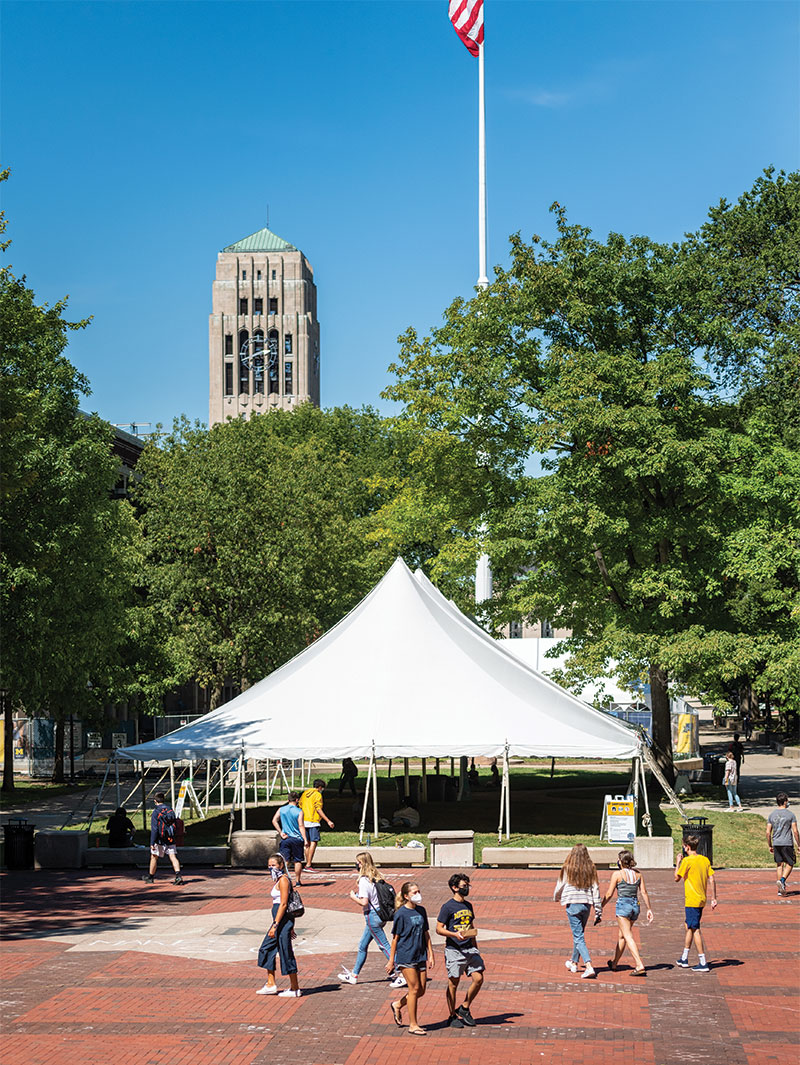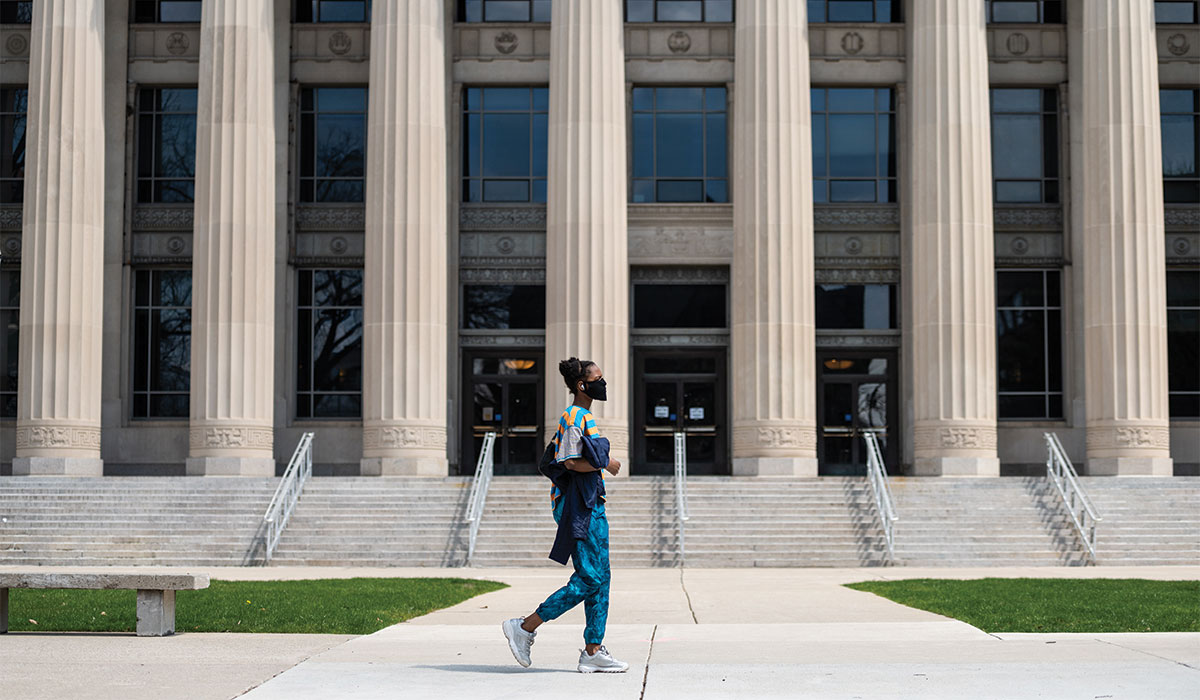The COVID-19 pandemic put a surreal spin on the arrival of the University’s 2020-21 academic year. Students started the year by committing to face coverings and social distancing. The University adapted its policies for entering facilities to lessen the spread of the disease. Everything from the academic calendar to grades were modified for a new normal. To give readers a better idea of life on campus, Michigan Alumnus has compiled this partial list of changes on campus as classes started Aug. 31.
The Campus Maize & Blueprint
On June 22, three months after classes moved to remote learning due to COVID-19, U-M President Mark Schlissel announced plans for a fall semester reopening. In making the announcement, he said students could choose to return to campus or study from home in a fully remote mode. Schools, colleges, and departments would decide the format for courses based on factors including public health guidelines. “We will protect our students, faculty, and staff with a broad array of research-based public health measures and tools,” Schlissel wrote in an email to the U-M community.
“We will make full use of our longstanding excellence in teaching and learning, both in person and online.”
At the same time, the University launched the Campus Maize & Blueprint, a comprehensive website with information about plans for all three campuses and Michigan Medicine. Along with guidelines for living, learning, and working on campus and regular updates, the site includes the COVID-19 Dashboard for the Ann Arbor campus. The dashboard includes data on the number of cases and tests, positivity rates, and isolation numbers.
Tracking Testing
During the fall semester, U-M President Mark Schlissel is providing the campus community with weekly email updates on COVID-19 testing of students, faculty, and staff. On Sept. 3, he shared the following data.
- 5,800 – Approximate number of students who completed the required pre-arrival COVID-19 test from Quest Diagnostics because they live in campus housing
- 21 – Number of those students who tested positive and were encouraged to see their local health provider and helped with plans for a delayed arrival to campus
- 6,000 – Approximate number of students who were tested upon arrival at U-M and asked to practice enhanced social distancing in their campus housing rooms until they received their test results
- 22 – Number of those students who tested positive under that program
- 500 – Number of tests available per week for the first three weeks of classes to the roughly 3,000 students living in fraternities and sororities
- 78% – Number of undergraduate credits being taught remotely
- 3,000 – Number of students, faculty, and staff who will be tested weekly by the U-M COVID-19 Community Sampling and Tracking program (see below)
COVID-19 Sampling and Tracking
On Sept. 9, the University launched the U-M COVID-19 Community Sampling and Tracking program. The free, voluntary surveillance program tests up to 3,000 students, faculty, and staff per week for the virus that causes the disease.
“The community sampling and tracking program will provide U-M public health experts with early warning signs and an opportunity to identify groups in our community in need of targeted support to slow COVID-19 transmission,” said Emily Martin, associate professor of epidemiology in Public Health, who is guiding the development of the program.
Each week, a sample of approximately 3,000 participants is selected to create a representative sample of the campus community. Participants are tested at Palmer Commons through an observed, self-collected nasal swab. Those with a positive test will be contacted for follow-up.
The program — part of a larger, multi-tiered testing and monitoring strategy — runs through Nov. 20.
Wolverine Culture of Care
Before the start of classes, students were required to complete a virtual course on COVID-19. According to an Aug. 21 article in the University Record, the Wolverine Culture of Care initiative promotes responsibility among members of the University community by doing the following:
- Monitoring themselves for symptoms associated with COVID-19 and carrying out the appropriate testing, isolating, and contact tracing efforts
- Practicing social distancing
- Wearing face coverings
- Adhering to size limitations for gatherings
- Frequent hand washing
- Educating themselves and others with health-positive and fact-based information related to COVID-19
COVID-19 Research
U-M researchers across a variety of disciplines are using their expertise to address COVID-19 on campus.
Environmental Study
Researchers at U-M’s School of Public Health are studying samples collected on campus from sewers, classrooms, and buses, while also taking measurements of the air. The goal is to determine how much of the coronavirus is present in the environment on campus and whether that has any relationship to COVID-19 infection rates within the University community.
“By making measurements before the start of the semester, and then continuing to sample the same locations over time as students, staff, and faculty come back to campus, we can see how the amount of virus in the environment relates to infection rates,” said Rick Neitzel, U-M associate professor of environmental health sciences. “The two must be related, but nobody has looked at this yet.”

Transportation Study
Wanting to make the bus system safer this fall, Michigan Engineering researchers simulated how aerosol particles exhaled from passengers sitting in any seat would travel through the vehicle under various conditions. In addition to developing physics-based computer models of aerosol dispersion — and validating them with experiments using water vapor — they also used algorithms to overhaul routes, which reduced passenger time on buses to minimize possible exposure to the virus. The new system of direct routes keeps rides under 15 minutes, while still enabling frequent service with the same number of buses and shorter wait times.
“Most passengers will still only take one bus to reach their destination, and all passengers can find nearby bus stops within five minutes’ walk of their starting and ending locations,” said Siqian Shen, an associate professor of industrial and operations engineering, who studies design and optimization of complex systems, including transportation networks.
Since Aug. 24, all bus riders and drivers have been required to wear face coverings, keep windows open, and fill only half the bus. The University’s bus fleet provided an estimated 8 million rides on its Ann Arbor campus last year.
GEO Strike
On Sept. 16, members of the Graduate Employees’ Organization (GEO) voted to end a strike that started Sept. 8 and resulted in an initial four-day work stoppage. The strike extended into the following week as discussions with the University continued.
The GEO, which represents about 2,000 graduate student instructors (GSIs) and graduate student staff assistants (GSSAs), voted 1,074-239 with 66 abstentions to accept the University’s second offer.
The union organized throughout the summer around these eight demands related to COVID-19 and anti-policing on campus:
- Transparent and robust testing, contact tracing, and safety plans for campus
- Support for GSIs working remotely and an option to switch to remote from hybrid/in-person
- Flexible subsidies for parents and caregivers, including those with school-aged children or care obligations for adults
- For international students, better International Center support and the repeal of the $500 international student fee and document shipping fee
- Unconditional support for all graduate students in the form of timeline and funding extensions, an emergency grant, and flexible leases and rent freezes at U-M housing
- A demilitarized workplace
- Diversion of funds from campus police (involving a cut of 50% to DPSS’ annual budget)
- Ending any and all ties to local law enforcement (AAPD) and other agencies (ICE)
University spokesperson Rick Fitzgerald stated that most of the issues were unrelated to the employment status of GEO members. He added that the GEO called for a strike even though state law and the current GEO contract with U-M prohibit such action. The GEO ratified a new three-year collective bargaining agreement with the University in April. That agreement guarantees GEO members a pay increase of at least 3% in each of the next three years.
In a Sept. 17 University Record article, Fitzgerald wrote that the University’s proposal created a stronger process to address health and safety concerns for GEO members working on campus and enabled GSIs and GSSAs to appeal any decision requiring them to work on campus. The University also improved a proposal to make temporary enhancements to student child care subsidies. Earlier that week, U-M President Mark Schlissel and Provost Susan M. Collins committed to engaging the campus community on the topic of policing. In addition, Rackham Graduate School Dean Michael Solomon continues to work with graduate students on ways to provide support for extra time to complete their degrees due to COVID-19 related disruptions to their Ph.D. research.
A Season Delayed
When the fall term started Aug. 31, the Big Ten Conference had postponed all fall sports due
to COVID-19. However, on Sept. 16 the conference announced the return of the 2020 football season. The eight-game schedule for U-M and all other Big Ten schools starts the weekend of Oct. 23-24. As Michigan Alumnus went to press, the state of Michigan’s public health limitations did not allow for fans to attend at-home athletic events.
The Big Ten also announced an agreement for conference-wide rapid testing starting Sept.
30 that will allow each school to test student-athletes and staff on a daily basis. “Great news today,” said Jim Harbaugh, ’86, U-M’s head football coach. “Over the past month, I could sense the anticipation from our players and coaches, and I’m thrilled on their behalf that they will have a chance to play a 2020 season.”
U-M President Mark Schlissel, who earlier had voiced concerns about the health and safety of intercollegiate athletics moving forward during the pandemic, also issued a statement shortly after the announcement.
“As has been so true during this pandemic, we continue to learn more every day and we have adjusted our approach based on the new information that was developed. I especially want to thank the health and safety officials from the Big Ten campuses who have carefully assessed the risk and developed a stringent plan — that will include daily COVID-19 testing — to mitigate those risks for our student-athletes, coaches, and others.”

Campus Facilities
The University has restricted access to campus buildings with the start of the fall term, including the following.
ResponsiBLUE
Before entering University facilities, members of the U-M community must answer three yes-or-no questions — regarding COVID-19-related symptoms and contact with someone diagnosed with the disease — using the ResponsiBLUE tool. Based on their replies, they receive either a green screen indicating they can enter or a red screen indicating they cannot.
Libraries
When classes started Aug. 31, services had been scaled back. Study spaces and limited computing were available by reservation in the Shapiro Library from 9 a.m. to 5 p.m., Monday through Friday. In addition, the library offered contactless pickup for materials not available online.
University Unions
The Michigan Union, Pierpont Commons, and Michigan League are all open with limited hours to anyone with an MCard. To ensure safety, everyone is required to wear a face covering and practice social distancing.
Loaning Laptops
“We want to enhance support to students with remote learning needs — both distance and on-campus — and ensure the removal of technology obstacles they may face by providing, as quickly as possible, well-equipped laptops.”
— Bob Jones, executive director of support services for Information and Technology Services, discussing the new Sites @ Home laptop loaner program now available to UM-Ann Arbor students
Grading Changes
“We are making these changes with the understanding that the COVID-19 pandemic is creating inequitable circumstances for students to pursue their coursework and demonstrate their learning.”
—U-M Provost Susan Collins, in the University Record, on modified grading for undergraduate courses on the Ann Arbor campus. In addition to A-C grades, students can receive a No Record COVID (NRC) instead of a D or E on their permanent transcript.
Know Where to Throw
To reduce density in the dining halls, MDining is serving meals — an estimated 95,000 each week — in takeout containers. Most of the containers are fully compostable, and MDining has posted signs encouraging diners to take sustainable steps toward waste reduction. This is part of an effort to advance the University’s commitment to reducing the total waste on campus by 40% by 2025.
Academic Calendars
To reduce travel to and from campus, the University has revised its 2020-21 academic calendars by eliminating fall and winter breaks and not having students return after Thanksgiving recess.
Fall Term 2020
Aug. 31 – Nov. 20 – Fall term classes
Nov. 21-29 – Thanksgiving recess
Nov. 30 – Dec. 8 – Fall term classes (remote only)
Dec. 10-18 – Final exams (remote only)
Winter Term 2020
Jan. 18 – Martin Luther King Jr. Symposium
Jan. 19 – April 20 – Winter term classes
March 14 – University Honors convocation
April 22-29 – Final exams





